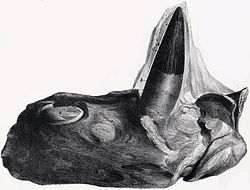Polyptychodon
 From Wikipedia the free encyclopedia
From Wikipedia the free encyclopedia
| Polyptychodon Temporal range: Late Cretaceous, | |
|---|---|
 | |
| P. interruptus jaw with tooth | |
| Scientific classification | |
| Kingdom: | |
| Phylum: | |
| Class: | |
| Order: | |
| Suborder: | |
| Family: | |
| Subfamily: | |
| Genus: | †Polyptychodon |
| Binomial name | |
| †Polyptychodon interruptus Owen, 1841[1] | |
| Other species | |
| |
Polyptychodon (meaning 'many-folded tooth') is a genus of pliosaurid found in Middle-Late Cretaceous marine deposits in southern England, France and Argentina. It has been considered a nomen dubium in a 2016 review.[2]
History of discovery[edit]

The type species, P. interruptus is known from an isolated tooth from the Late Cretaceous Chalk Group of southern England.[1] Owen described a second nominal species of the genus, P. continuus, from an isolated tooth collected in the Hythe Formation of Maidstone, Kent. (The macronarian sauropod Dinodocus was mistakenly thought to be conspecific with P. continuus before it was correctly recognized as a dinosaur and not a plesiosaur.)
Numerous pliosaurid teeth and vertebrae from England and eastern France have been previously assigned to Polyptychodon, including isolated vertebrae from France which were misidentified as a sauropod.[3] Comparison between Albian-age isolated vertebrae from marine deposits in France and Kronosaurus suggested a size of approximately 7 metres (23 ft) for a Polyptychodon-like brachaucheniine pliosaurid.[3] However, a 2016 re-evaluation found Polyptychodon and its types species to be dubious, and that numerous remains from the Chalk Group in England that had been referred to the genus most likely represent different species of plesiosaurs, with some teeth possibly being referable to Polycotylidae.[2] Similar fossils of pliosaurs were found also in Czech Republic.[4]
The species Polyptychodon patagonicus (Ameghino, 1893), based on crocodile teeth discovered in Argentina, shares the same genus name. According to a 2010 study, P. patagonicus is a nomen vanum and a nomen dubium.[5]

Polyptychodon hudsoni (holotytpe, SMU 60313) was described from the Turonian-age Eagle Ford Formation of Dallas, Texas.[6][7] It probably belongs to a different genus.[2][8]
See also[edit]
References[edit]
- ^ a b c Owen R. (1841). Odontography. London: Hippolyte Baillière. p. 655.
- ^ a b c Madzia D. (2016). "A reappraisal of Polyptychodon (Plesiosauria) from the Cretaceous of England". PeerJ. 4: e1998. doi:10.7717/peerj.1998. PMC 4867712. PMID 27190712.
- ^ a b Buffetaut E, Colleté C, Dubus B, Petit J-L. (2005). "The "sauropod" from the Albian of Mesnil-Saint-Père (Aube, France): a pliosaur, not a dinosaur". Association Géologique Auboise, Bulletin Annuel, Sainte-Savine. 26: 3–8.
{{cite journal}}: CS1 maint: multiple names: authors list (link) - ^ "Druhohorní plazi v Čechách II" [Mesozoic reptiles in Bohemia, part 2] (in Czech). 13 July 2015.
- ^ J. P. O'Gorman; A. N. Varela (2010). P. Mannion; J. Tennant (eds.). "The oldest lower Upper Cretaceous plesiosaurs (Reptilia, Sauropterygia) from Southern Patagonia, Argentina". Ameghiniana. 47 (4): 447–459. doi:10.5710/AMGH.v47i4.3. S2CID 129812539.
- ^ Welles SP, Slaughter BH (1963). "The first record of the plesiosaurian genus Polyptychodon (Pliosauridae) from the New World". Journal of Paleontology. 37 (1): 131–133.
- ^ "Plesiosaur Unearthed During Preliminary Excavation for the Dallas-Fort Worth International Airport".
- ^ Madzia, Daniel; Sachs, Sven; Lindgren, Johan (2019). "Morphological and phylogenetic aspects of the dentition of Megacephalosaurus eulerti, a pliosaurid from the Turonian of Kansas, USA, with remarks on the cranial anatomy of the taxon". Geological Magazine. 156 (07): 1201–1216. doi:10.1017/S0016756818000523.






